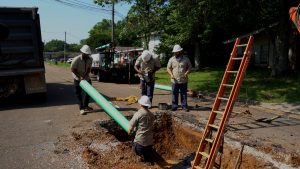City approves first sewer rate increase in 20 years for infrastructure improvements – City of Huntsville (.gov)

Report on Huntsville Sewer Rate Increase and Infrastructure Investment
Introduction
On June 26, 2025, the City of Huntsville approved its first sewer rate increase in 20 years. This decision aims to support critical infrastructure investments within the aging sewer collection system and five wastewater treatment facilities. The City Council passed the increase with a 4-1 vote.
Details of the Sewer Rate Increase
- The monthly sewer bill for an average residential customer will increase from $24.15 to $29.15.
- This new rate remains significantly below the Alabama state average sewer bill of $52.14 per month.
- Beginning in 2026, rates will increase by $1 per month annually until 2034.
- By 2034, the average residential sewer bill is projected to be $39.15, still below the current state average.
Infrastructure Investment Plan
The rate increase will fund a $150 million infrastructure investment over a 10-year capital plan focused on:
- Upgrading the sewer collection system
- Enhancing five wastewater treatment facilities
These investments are essential due to the aging infrastructure, with parts of the system dating back to the 1950s. Continuous reinvestment is necessary to maintain system reliability and compliance with regulatory standards.
Alignment with Sustainable Development Goals (SDGs)
This initiative strongly supports several United Nations Sustainable Development Goals:
- SDG 6: Clean Water and Sanitation – By upgrading sewer infrastructure, Huntsville ensures access to safe and reliable sanitation services, reducing water pollution and protecting public health.
- SDG 9: Industry, Innovation, and Infrastructure – The $150 million investment promotes sustainable infrastructure development and fosters innovation in wastewater management.
- SDG 11: Sustainable Cities and Communities – Improving sewer systems enhances urban resilience and sustainability, contributing to healthier living environments.
- SDG 13: Climate Action – Modernizing wastewater treatment facilities can reduce environmental impact and support climate resilience efforts.
Conclusion
The City of Huntsville’s sewer rate increase and infrastructure investment plan represent a proactive approach to sustainable urban development. By prioritizing long-term system reliability and environmental compliance, the city advances multiple SDGs, ensuring improved sanitation services and a healthier community for current and future generations.
1. Sustainable Development Goals (SDGs) Addressed or Connected
- SDG 6: Clean Water and Sanitation – The article focuses on sewer system infrastructure, wastewater treatment, and maintaining reliable sanitation services.
- SDG 9: Industry, Innovation, and Infrastructure – The investment in aging infrastructure and modernization of sewer systems aligns with building resilient infrastructure.
- SDG 11: Sustainable Cities and Communities – Ensuring sustainable urban infrastructure and services such as wastewater management is part of creating sustainable cities.
2. Specific Targets Under Those SDGs
- SDG 6 Targets:
- 6.3: Improve water quality by reducing pollution and minimizing release of hazardous materials, increasing recycling and safe reuse.
- 6.1: Achieve universal and equitable access to safe and affordable drinking water (implied through maintaining sanitation infrastructure).
- 6.a: Expand international cooperation and capacity-building support to developing countries in water and sanitation management (implied by infrastructure investment and upgrades).
- SDG 9 Targets:
- 9.1: Develop quality, reliable, sustainable, and resilient infrastructure, including regional and transborder infrastructure.
- 9.c: Increase access to information and communications technology and strive to provide universal and affordable access to the Internet (implied by modernization efforts).
- SDG 11 Targets:
- 11.6: Reduce the adverse per capita environmental impact of cities, including by paying special attention to air quality and municipal and other waste management.
3. Indicators Mentioned or Implied to Measure Progress
- SDG 6 Indicators:
- Proportion of wastewater safely treated (indicator 6.3.1) – implied through investment in wastewater treatment facilities.
- Proportion of population using safely managed sanitation services (indicator 6.2.1) – implied by sewer system reliability and upgrades.
- SDG 9 Indicators:
- Proportion of the rural population who live within 2 km of an all-season road (indicator 9.1.1) – indirectly related to infrastructure access.
- Proportion of population covered by a mobile network, by technology (indicator 9.c.1) – implied by modernization but not explicitly mentioned.
- SDG 11 Indicators:
- Annual mean levels of fine particulate matter (PM2.5) in cities (indicator 11.6.2) – indirectly related to environmental impact of waste management.
- Proportion of municipal solid waste collected and managed in controlled facilities (indicator 11.6.1) – implied through sewer system maintenance and treatment.
4. Table: SDGs, Targets and Indicators
| SDGs | Targets | Indicators |
|---|---|---|
| SDG 6: Clean Water and Sanitation |
|
|
| SDG 9: Industry, Innovation, and Infrastructure |
|
|
| SDG 11: Sustainable Cities and Communities |
|
|
Source: huntsvilleal.gov








